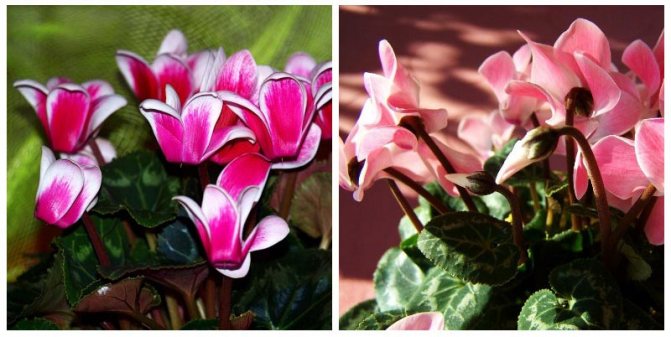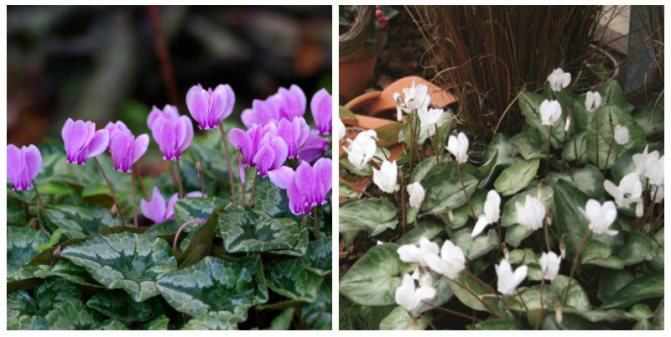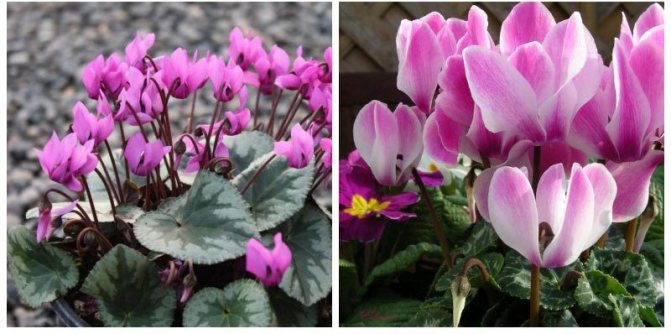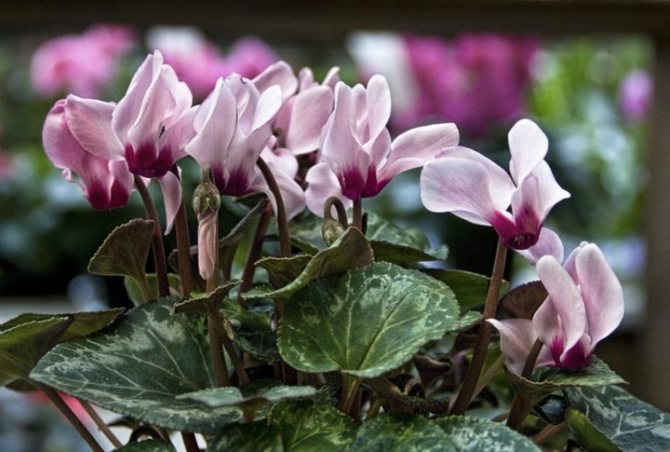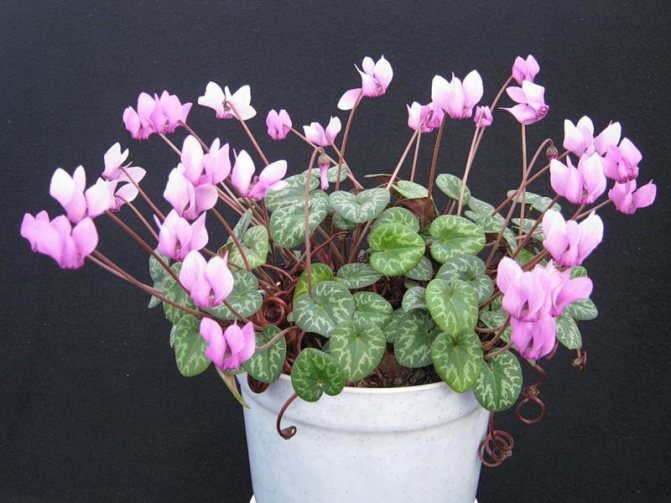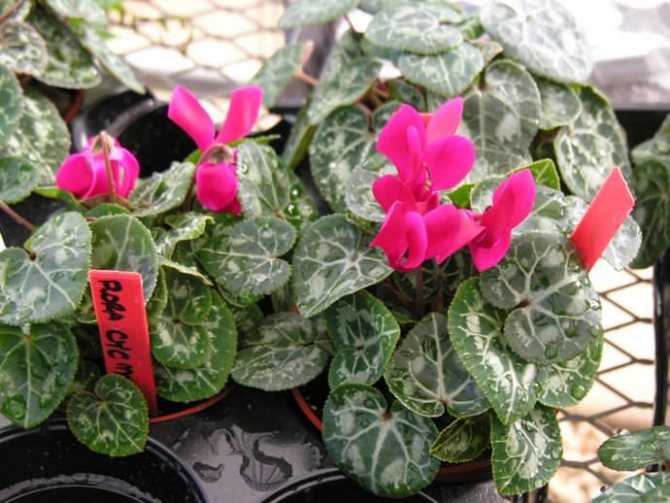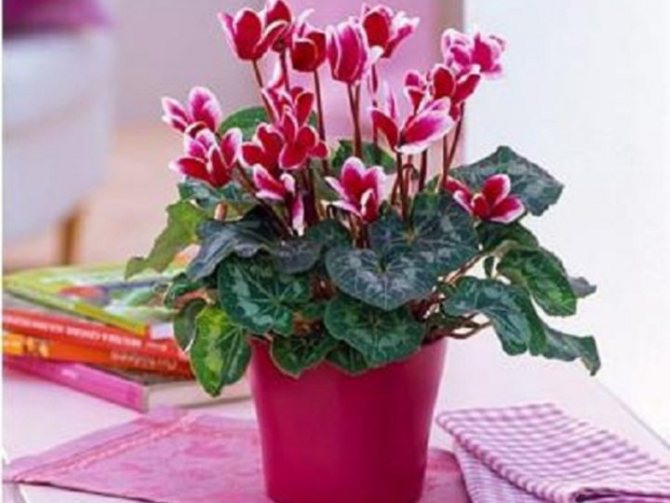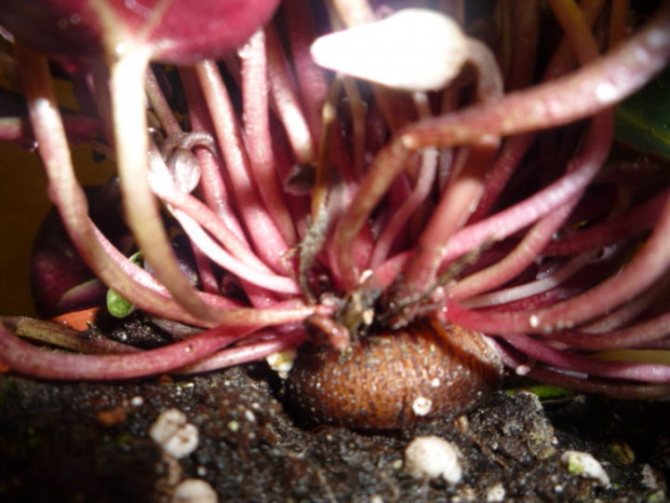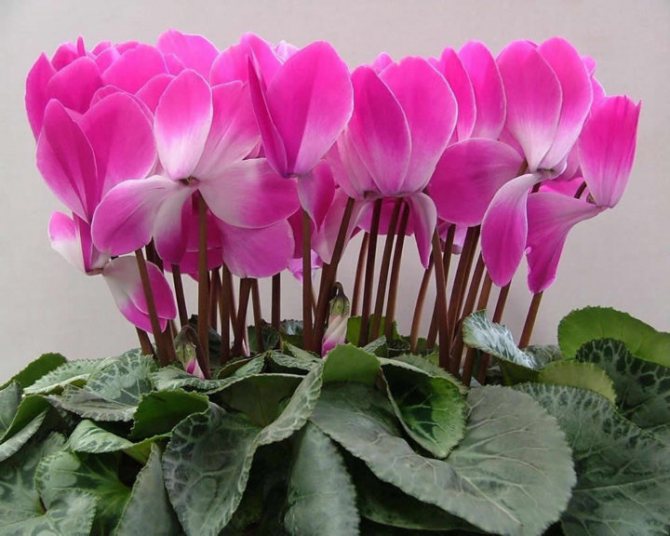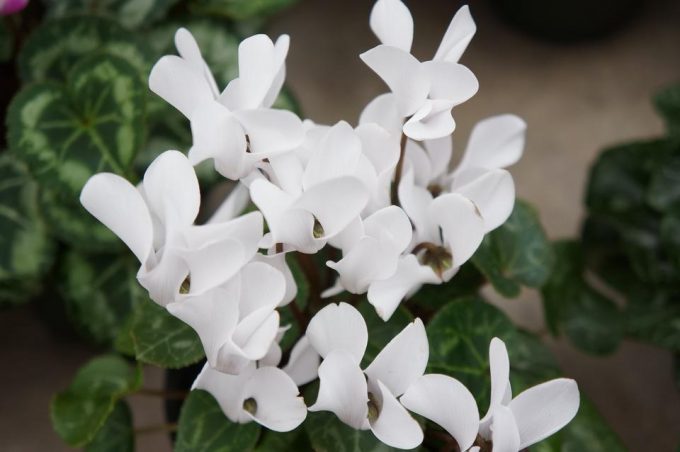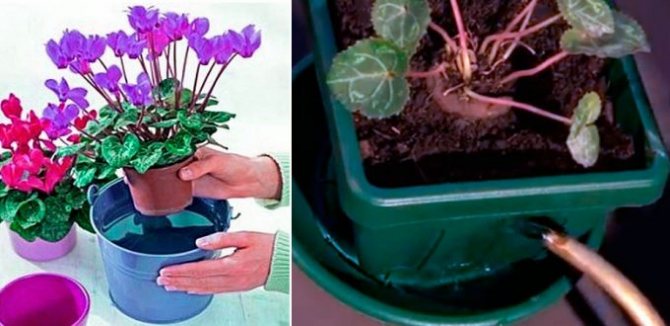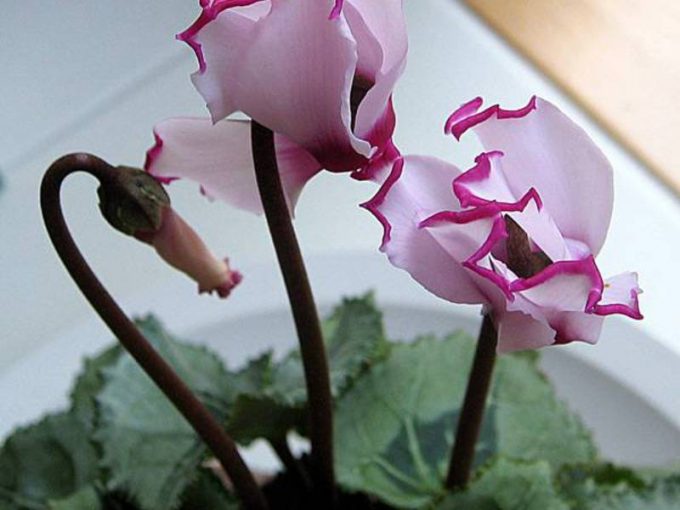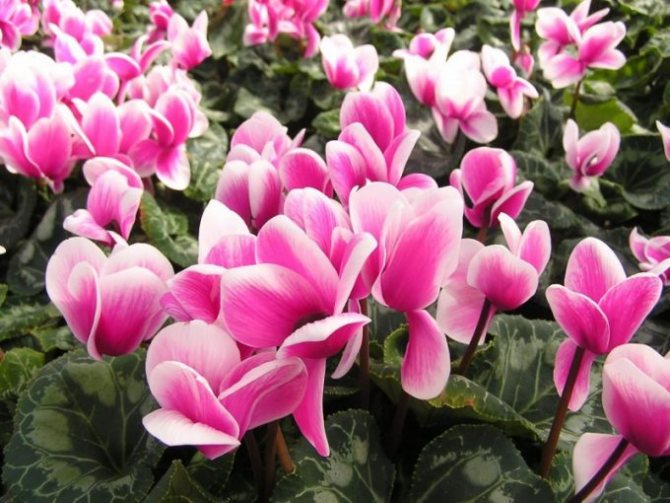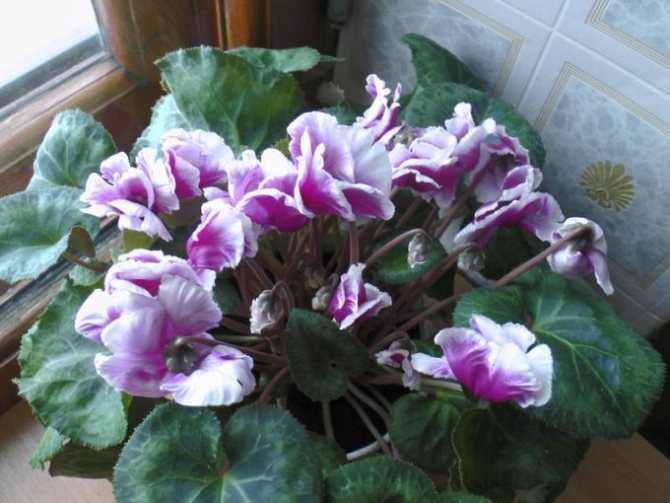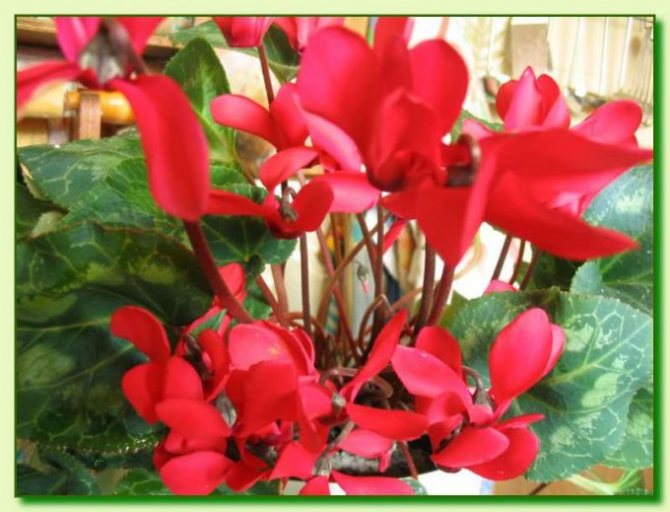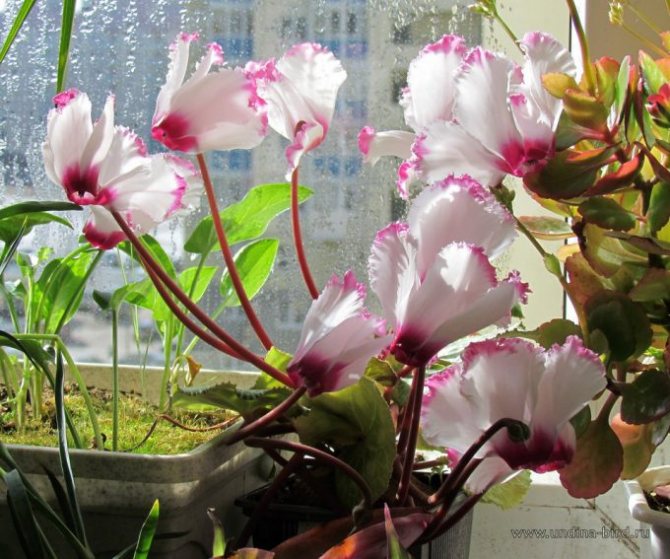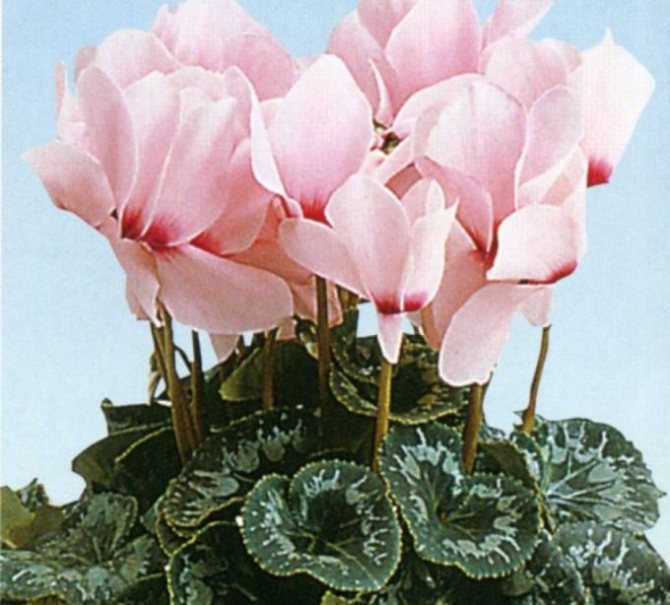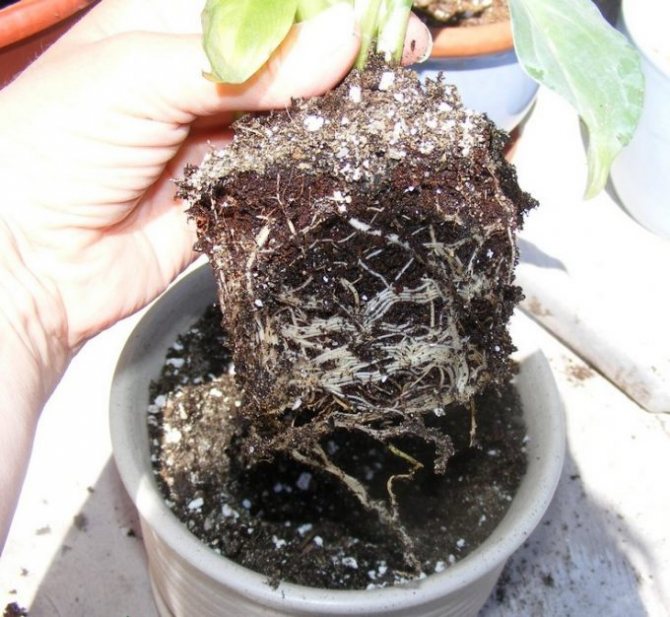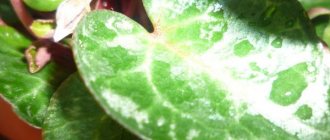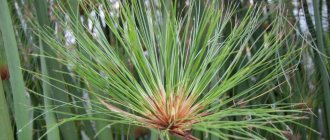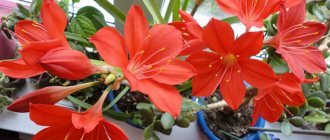Cyclamen
This amazingly beautiful plant is also often called the alpine violet - because of the area of its distribution. Its root visually resembles a circle, which is reflected in the name, derived from the Greek word "Kyklos". Persian cyclamen, like its other species, came to our country from the Mediterranean coast of Central Asia and Southern Europe. Today we will tell you about what this houseplant looks like, how to care for it, in particular during the dormant period, how reproduction takes place, and what difficulties you may encounter.
Description
At home, indoor plant lovers most often contain Persian, European, Caucasian, ivy-leaved cyclamen. In our article, we will focus on the beautiful and graceful Persian cyclamen, also called the Alpine violet and dryak.
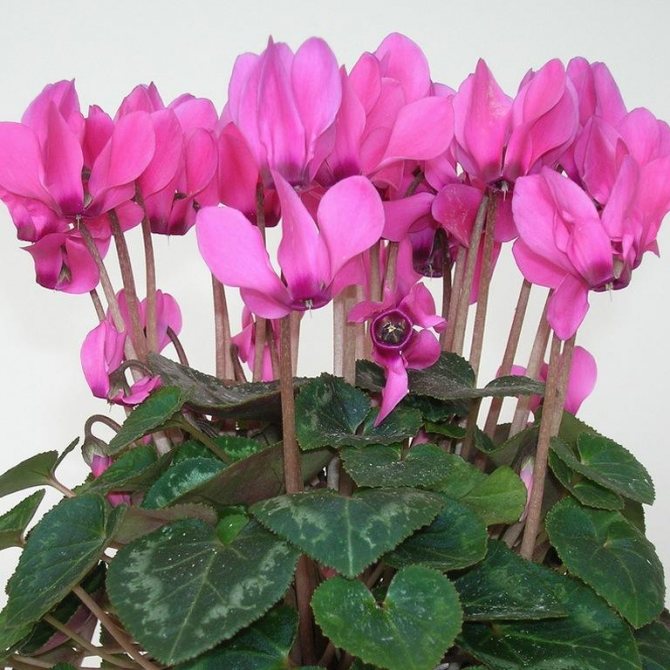
Persian cyclamen is a perennial herbaceous crop, tuberous, which usually does not grow more than 30 centimeters in height. Tubers rarely exceed 15 cm in diameter and have one growth point. At home, Persian cyclamen is grown, the flowers of which are white, red, purple or pink in color. The leaves have received a heart-shaped shape, their diameter is 14 cm. On the surface there is a marble and white pattern. Flowering occurs from autumn to early spring, dormant time occurs in May - June.
European cyclamen is not particularly different from the first type. The cyclamen tuber is smaller in diameter - up to 10 cm. The roots can have an irregular shape. Subsidiary tubers are located on the underground stolons of European cyclamen. On its leaves there is a silvery pattern - this can be found on the surface and Persian leaves. Cyclamen European has heart-shaped leaves, the diameter of each is 2 - 4 cm. That is, the size of the leaves and flowers of the European species is somewhat smaller than that of the Persian.
How to grow cyclamen (video)
Through many years of efforts of domestic and foreign breeders, the most unpretentious varieties of European cyclamen were bred, which, unlike other species, do not need a winter dormant phase as such, which makes it possible to significantly simplify, if not all, then very measures for caring for indoor perennials. It is important to consider that both species have pronounced medicinal properties, therefore, in order for the plant to bring full benefits, it will need to provide full care.
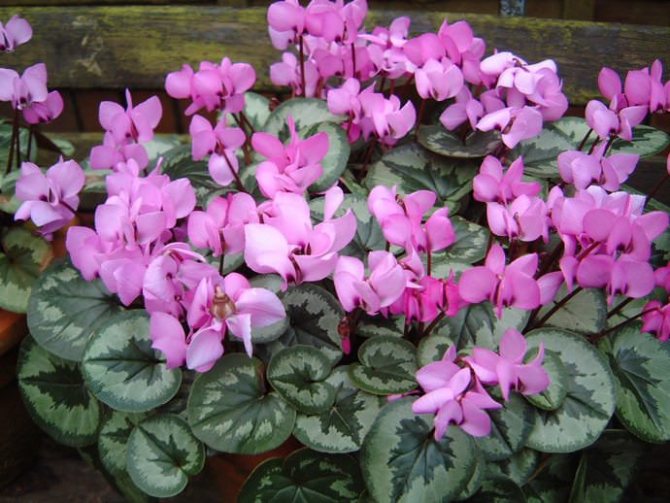

Home care
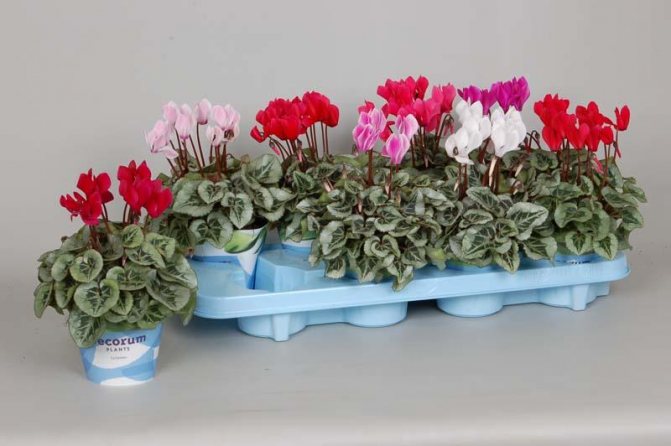

You need to take care of the flower correctly. The temperature in the room is maintained at the level of +12 - 15, at night - at least 10 degrees Celsius. He needs bright, but diffused lighting. It is recommended to place Persian cyclamen on the eastern windows. Do not expose the plant to sunlight. This indoor culture has a negative attitude towards tobacco smoke and gas fumes. Keep the air clean. Do not place the pot next to a radiator or in a draft. Cyclamen does not tolerate purity, put it away from other flowers.
Normal humidity in the room for him is 50%. It is permissible to spray the air near the plant. A pallet is often placed next to the pot, where wet expanded clay is located.Cyclamen Persian care involves moderate but constant watering with warm water, avoiding contact with leaves and tuber. Excess liquid from the pallet must be drained. Apply fertilizers during the period of leaf growth and flowering every couple of weeks. They should be added to the water for irrigation. The leaves must be cleaned with a soft brush.
Growing problems
As a rule, a significant part of the problems accompanying the cultivation of decorative perennials are the result of improper care, including overflow, underfilling, cultivation in rooms with too dry air or extremely high temperature conditions:
- the appearance of brown spots on the foliage of European cyclamen, yellowing and wilting of leaves, can be caused by too dry air in the room or too intense lighting of the aboveground part. In this case, the decorative perennial must be transferred to a shaded place, and also the air humidity should be increased;
- if the plant drops buds at the stage of flower stalking, then it is required to transfer the culture to a warmer and lighter room;
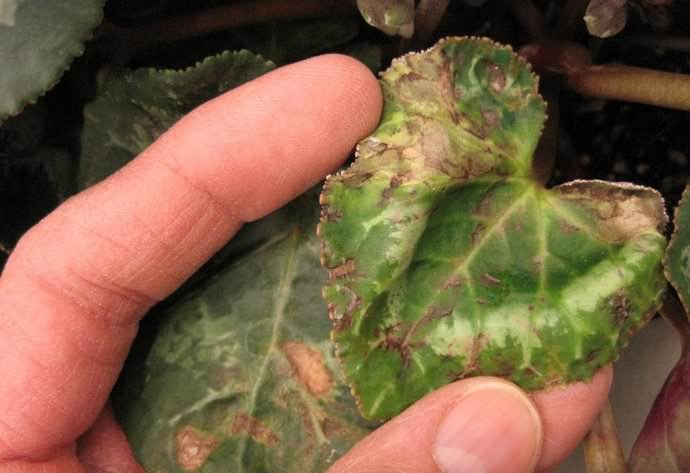

- foliage withers, turns yellow, becomes lethargic if there is a strong waterlogging of the soil, as a result of which the root system rotted. The dug tuber must be carefully examined and any damaged or rotten parts cut off;
- Of the pests, the most dangerous for the culture are aphids, thrips and ticks, for the destruction of which the most and effective modern insecticides of a chemical type are used.
If the foliage of European cyclamen turns yellow and falls off in preparation for the phase of winter dormancy, then no therapeutic action should be taken, since such a process is natural.
How to care after flowering
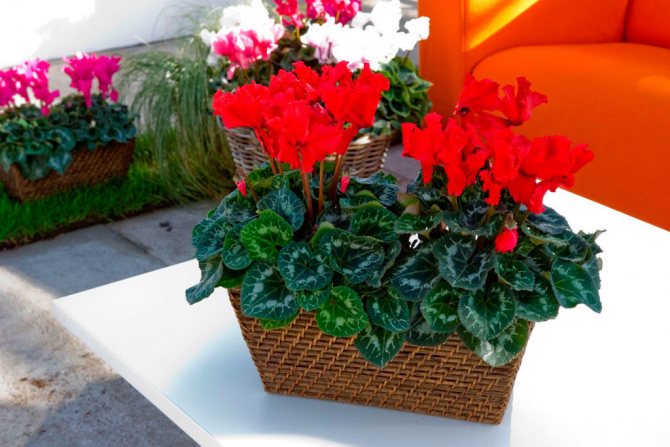

After 3 - 4 months of lush flowering, the plant begins a dormant period. It gets rid of yellowed foliage. The amount of watering should be reduced. The aerial part can die off even after 2 months. The pot during the dormant period is best placed in a cool shaded area where there is normal ventilation and does not bake the sun. In the summer, the flower is usually transplanted into a more spacious container using the transshipment method. There should already be a special peat mixture. The addition of sand will provide excellent drainage. You do not need to make it too greasy, so as not to provoke a disease with gray rot.
It is customary to transplant 2 times a year, but not in a cramped pot. Leave the upper part of the plant slightly above ground level, since the root system of the indoor crop traditionally grows in the lower part of the tuber. After completing the transplant procedure in the summer, it is not recommended to water. The appearance of new leaves occurs in September. When they are formed on the plant in the required amount, you can resume watering it. After that, take care of your pet in the same way as before the onset of the rest period.
Flowering time
Persian cyclamen blooms in the autumn-winter period, which is its clear advantage. Flowering begins in the second half of October and continues until the end of March. Cyclamen pleases us with its flowering for about 3.5 months !!! Flowering times may vary depending on the variety and conditions of detention. Persian Cyclamen can be seen on sale most often in winter, during the flowering period.
Cyclamen European blooms in spring and summer, almost until winter. Flowering begins in late spring. That is why Cyclamen European is most often bought in stores in spring or summer, in bloom.
The flowers of the European cyclamen are smaller than those of its Persian relative. But the shades of color are about the same: pink, white, dark red, purple in both species.
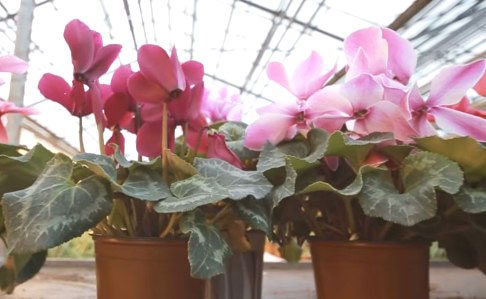

What problems can arise
Persian cyclamen in the process of growing can overcome various kinds of troubles. Among which it is worth mentioning the fleeting flowering - the reason lies in the lack of minerals in the heat. You can help by adding fertilizer and moving the pot to a cool place. The leaves are capable of withering and changing from green to yellow. This is due to the heat or the location of the plant in direct sunlight.
It is necessary to create a shade, do not let the ground dry out, spray. If leaves, shoots and peduncles begin to rot, then the reason often lies in waterlogging of the earth. It is necessary to water less often.
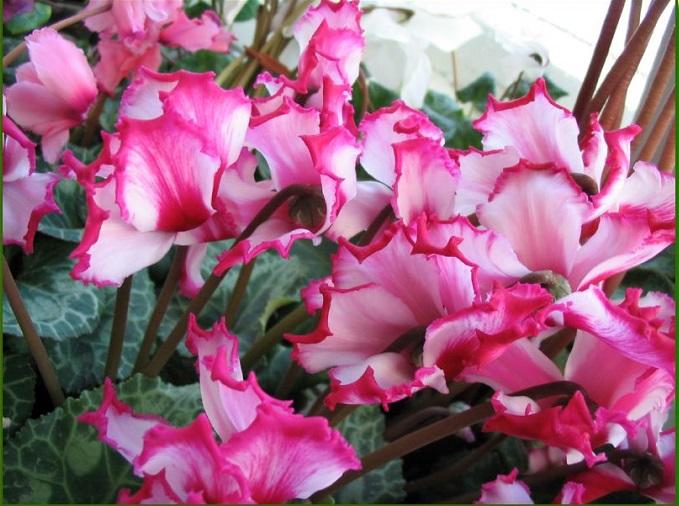

When deformed leaves are noticeable when growing a houseplant, we can safely say that your pet was attacked by pests. Cyclamen is most often annoyed by spider and cyclamen mites, trises and aphids. These small insects can cause significant harm to the normal growth and development of your pet. If you do not start fighting them in time, the plant may even die. Treatment with special insecticides, chemical and biological preparations has proven itself well. It is advised to remove the diseased parts of the bush, less often to water, reduce the temperature and humidity.
Preparing for a rest period
Intensive growth and flowering of most of the flower species occurs in autumn and winter. After the end of flowering, the plant begins to form buds. At this time, the cyclamen is being prepared for the rest period. On average, the dormant period lasts all spring and part of summer. You can notice the preparation of the plant for dormancy by the withering old leaves, their yellowing. At the same time, small young leaves begin to appear on the flower, which retain the spectacular appearance of cyclamen.
After the leaves are completely dry, they are removed from the plant. Cyclamen care during flowering should be minimal. The plant is placed in a dark, cool place with plenty of light. Feeding and moisturizing are completely stopped. Watering is also reduced to 2-4 times a week.
You can talk about the beginning of the spilling of leaves when new cuttings with leaves appear on the tuber. At this time, the flower is placed in a sunny place with diffused light, and is also insulated and, if necessary, transplanted.
Reproduction
Most often, when growing this beautiful plant at home, it is propagated using seeds, less often it is done by dividing the tuber. The first method is less dangerous for the flower. To get seeds at home, you need to have several plants. To obtain seeds, use a brush to transfer pollen from crop to crop. This is how artificial insemination takes place.
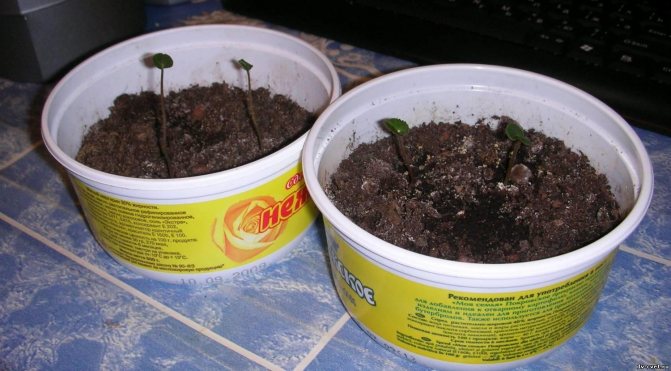

The peduncle begins to twist and transfers the box, in which the seeds are located, closer to the ground. Ripening seeds at home usually takes a couple of months. It is recommended to sow them after the opening of the seed box occurs. Sowing flower seeds is permissible at any time of the year. Experts believe that the most suitable period is spring. Before sowing, the seeds are advised to soak in the Epin preparation. For sowing, sterile, that is, steamed soil is most often used. They take small boxes or other containers, where seeds are embedded in the ground to a depth of about 1 cm, the distance between them is left up to 3 cm. The soil is soaked from above from a fine sprayer.
The containers are covered with black foil. The germination temperature is 18 - 20 degrees Celsius. When shoots appear after 30 - 40 days, the film is removed. At the stage of 2 leaves, a dive is carried out. Six months later, new cyclamens are planted in permanent small pots. Dividing tubers at home is rarely done. When the leaves die off, the tuber is cut in the center with a sharp knife so that each part remains with its own buds and roots.Sections are treated with fungicides, sprinkled with charcoal, allowed to dry and planted in separate pots.
Types and varieties of Persian cyclamen
Before starting to describe the various varieties, it is appropriate to explain how to distinguish Persian cyclamen from European, another species adapted for indoor growing, in order to already know exactly which plant is meant. The Persian cyclamen blooms in winter, which is one of its greatest values. Then, when most of the plants are not blooming, or, in principle, are in the phase of winter sleep, a bright cyclamen brings a small piece of spring into the house. European cyclamen blooms, like most plants, from spring to autumn, with smaller but very fragrant flowers.
The Persian cyclamen is a herb with large leaves and flowers that has a dormant period after flowering. The European cyclamen is an evergreen plant that does not hibernate, and its leaves and flowers are much smaller than those of the Persian relative. (By the way, if you put the sofa on a metal frame surrounded by these cyclamens, it will look pretty good).
Cyclamen Persian Victoria
To date, breeders have bred a huge number of various varieties of cyclamen, which differ from each other in the size of the whole plant, as well as in the size and shape of leaves and flowers.
Cyclamen Persian Victoria is one of the most common representatives of the species, its flowers are decorated with a crimson fringe and the same eye. The flower rosette is compact, and the plant itself is conventionally located somewhere in the middle between the mini and standard categories.
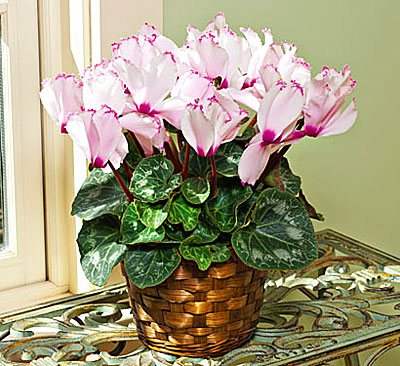

Cyclamen Persian Rococo
Cyclamen Persian Rococo is also one of the leaders among cyclamens and its peculiarity is its specifically twisted petals with a thick fringe. Flowers of this variety are deep pink without edging or spots. It is often placed on a windowsill between other plants, as well as in offices, where the vibrant color of its flowers creates a pleasant and warm atmosphere during the cold season.
Cyclamen Persian Barbarossa
Cyclamen Persian Barbarossa exists in a variety of colors, but the most common specimens are dark and light pink. The shape of the flowers is unlike any other; each petal has a characteristic beard in its very middle. The color is more saturated at the base of the petal, and the edges fade into white. This variety is very much loved and appreciated, despite the fact that it is quite fragile and sensitive to the microclimate, it often gets sick and dies.
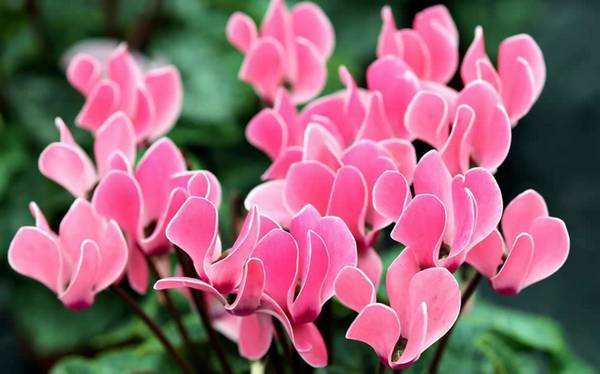

Cyclamen persian white
Cyclamen Persian white often evokes associations with purity and innocence. Its delicate flowers are absolutely snow-white, without any blotches or streaks. Contrasting with rich green leaves and forming a kind of white cloud above it, cyclamen leaves no one indifferent, and given the fact that it blooms in winter, it is very popular.
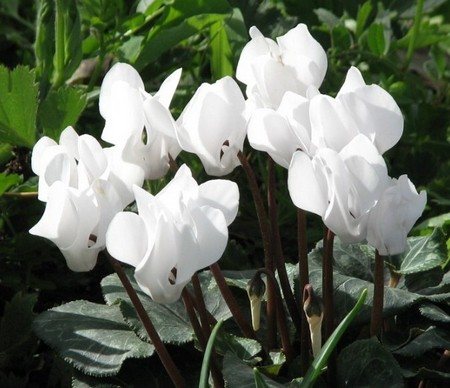

Cyclamen persian mini Aneli
Cyclamen Persian mini Aneli belongs to the category of small cyclamens and does not reach large sizes, but for such a delicate and delicate plant, this is rather a plus, not a disadvantage. Its white flowers with a purple eye are elongated on long arrows. A very good contrast and thanks to it the variety is incredibly popular.
Pests and diseases
Proper care ensures long-lasting flowering of the plant. However, if the rules of care are not followed, the plant is often exposed to diseases. With a prolonged stay of diseases on the bush, cyclamen may die.
Wet rot
When sluggish leaves and an unpleasant putrid odor appear on the plant, it is worth suspecting such a disease as wet rot. In this case, the plant rhizomes die off.Unfortunately, plants affected by wet rot cannot be saved. Therefore, you have to get rid of a sick cyclamen.
Gray rot
When the flower is in a damp and cold place, gray rot forms on the leaves. A fungus that forms on a flower forms a gray bloom on foliage and flowers. At the same time, wilting, yellowing and death of the flower occurs. To solve the problem, the affected parts of the flower are treated with fungicidal solutions and removed. Healthy parts of the plant should also be treated with a fungicide solution.
Fusarium wilting
Such a disease can be detected when yellow spots appear on the tips of the foliage. However, in this case, the fungus has already damaged the roots and stems of the plant. To eliminate the pathogenic organism, the plant is treated with a solution of foundationol. The medicine is injected under the roots of the flower in a solution of water.
Cyclamen mite
Cyclamen is most often affected by this type of pest. Since this mite does not exceed 0.5 mm in size, it is almost impossible to notice it. This type of mite lives on the seamy side of foliage. When a large number of mites form on a sheet, it appears that the sheet is covered with dust.
The symptoms of pathology are twisting of foliage and flowers, wilting of the plant and growth retardation. To restore the flower, the affected areas of the plant should be removed, and the bush should be transplanted into new soil.
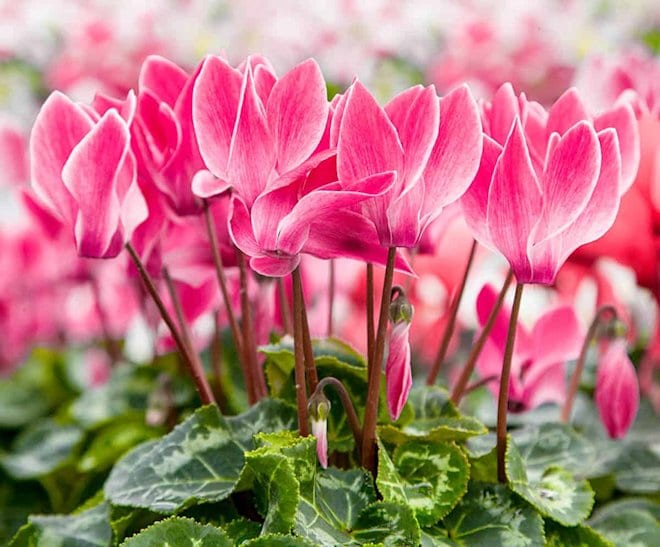

Aphid
A pest that spoils the appearance of the shrub. Since the aphids suck the juice out of the bush, a sticky bloom remains on the flower. It is possible to eliminate and prevent the pest by treating the cyclamen with insecticidal solutions.
Thrips
The danger of these insects is that the larvae are deposited on the inside of the leaves. The larvae feed on the sap of the plant. Symptoms of the presence of pests on foliage are brown spots. In this case, the deformation of the flowers occurs. Since thrips carry viruses, the flower is regularly treated with chemicals.
Root rot
Symptoms of the presence of root rot are the appearance of pale foliage and the appearance of dark areas on the corms. Poorly sterilized soil is considered the cause of this disease. To solve the problem, the soil is treated with fungicidal solutions.
Anthracnose
In this case, the disease affects the peduncles. The peculiarity of the pathology is the cessation of growth and flowering, damaged flowers fall off. Leaves also wither - first curl, then dry up. The reason for this condition is often improper care of the bush - excessive humidity and high temperature. When troubleshooting, the damaged leaves are cut off, and the wounds are treated with soapy water.
Sooty fungus
The picture of such a pathology is due to the appearance of a dark bloom on the leaves. In this case, the foliage stops growing and blooming, and the foliage dries up. To solve the problem, the foliage is washed with a mild soapy solution or clean water. Treatment with fungicidal agents is also effective.
The healing properties of the cyclamen plant
The fact that the cyclamen root has healing properties was known and used in his practice by Hippocrates for the treatment of rheumatism, sinusitis and as an antidote for the bites of poisonous snakes. It is currently used for the manufacture of medicines that have a sedative, anti-inflammatory and antimicrobial effect.
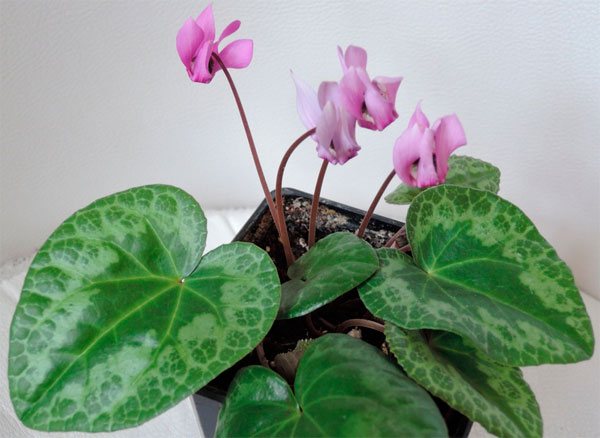

Infusions and extractscontaining cyclamen are used for increased excitability, depression, nervousness, headaches and insomnia. It is also used for radiculitis and osteochondrosis.
Fresh juice cyclamen is used to treat gynecological diseases and sinusitis. Also widely used is cyclamen oil, which is an oil extract using grape seed oil.
Cyclamen Caucasian is widely used in homeopathy.Its natural habitat is the Krasnodar Territory, Georgia, Azerbaijan, the Eastern Mediterranean, the Balkans and Asia Minor. Therefore, many will be able to find out what a Caucasian cyclamen looks like only from a photo. It is located on the slopes of the mountains and in the forest among the bushes. Refers to the species that are listed in the Red Book, as it is on the verge of extinction due to the digging of tubers for medicinal purposes and collecting flowers for spring bouquets.
But with so many useful properties, you need to remember that cyclamen is poisonous plant, and do not self-medicate without consulting a doctor.
The slightest non-compliance with the dosage can cause severe poisoning, while vomiting begins, headaches appear. It can also be accompanied by breathing difficulties and seizures. In this case, you urgently need to rinse the stomach with further taking an antispasmodic agent and seek medical help.

